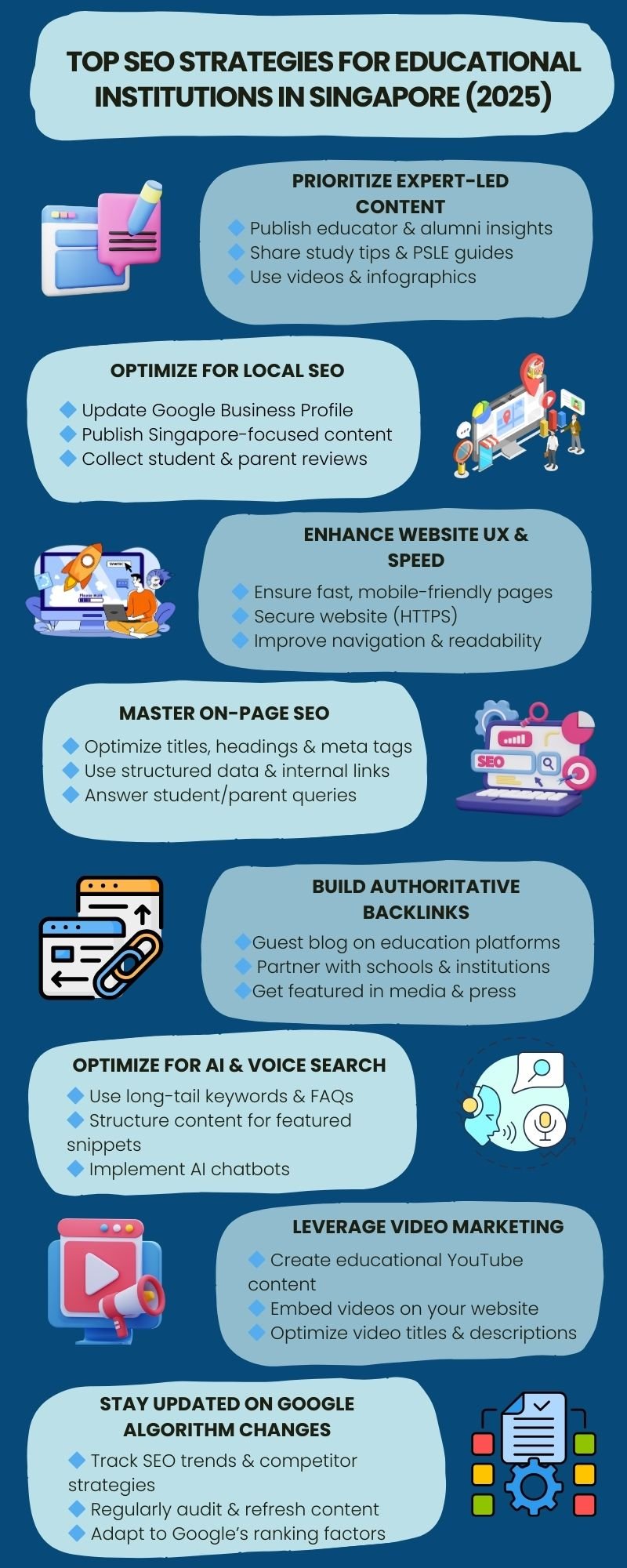With increasing competition in Singapore’s education sector, ranking high on search engine results pages (SERPs) is more crucial than ever. Parents and students rely on online searches to find the best schools, tuition centers, and e-learning platforms. To secure top positions in 2025, educational institutions must focus on SEO strategies that align with Google’s E-E-A-T (Experience, Expertise, Authoritativeness, and Trustworthiness) principle.
This guide covers proven SEO tactics to enhance your institution’s online visibility and attract high-quality traffic.
1. Prioritize Content with Experience and Expertise
Google values content that reflects first-hand experience and industry expertise. Educational institutions should publish well-researched, original, and valuable content that answers the queries of students and parents.
How to Implement:
Publish Expert-Led Content: Have educators, subject matter experts, or alumni share their insights on academic programs, learning methodologies, and success stories.
Create Student-Centric Resources: Develop guides, study tips, and exam preparation materials to address students’ needs.
Use Interactive Media: Leverage videos, podcasts, and infographics featuring real educators explaining complex topics in simple terms.
Example: Instead of a generic “How to Prepare for PSLE,” create a detailed, step-by-step guide written by an experienced tutor, including real-life success stories.
2. Optimise for Local SEO to Capture Nearby Searches
Parents and students often search for “best tuition center near me” or “top private schools in Singapore”. Google prioritizes geographically relevant results, making local SEO essential.
How to Implement:
Google Business Profile (GBP) Optimisation: Keep your address, contact details, and operating hours updated on Google.
Localised Content Strategy: Publish Singapore-focused articles on topics like MOE syllabus updates, tuition grants, and PSLE strategies.
Get Reviews & Citations: Encourage parents and students to leave authentic reviews and ensure your institution is listed on local directories and education portals.
Example: A tuition center ranking for “Best Math Tuition in Jurong” can boost its SERP position by publishing student success stories with geo-specific keywords.
3. Improve Website User Experience (UX) and Core Web Vitals
Google rewards fast, mobile-friendly, and secure websites. If your website is slow or difficult to navigate, visitors will leave, increasing your bounce rate and harming your SEO.
How to Implement:
Speed Optimisation: Compress images, enable browser caching, and use a Content Delivery Network (CDN).
Mobile-First Design: Ensure easy navigation, readable fonts, and fast loading times on mobile devices.
Secure Website (HTTPS): Google prioritises secure websites. If your site is not HTTPS-encrypted, upgrade immediately.
Example: A slow-loading tuition center website could lose visitors. By optimising images and fixing server issues, page speed improves, leading to higher engagement and better rankings.
4. Master On-Page SEO for Educational Queries
On-page SEO for educational institutes ensures that your website’s content is optimised for search intent and structured for search engine crawlers.
How to Implement:
Optimise Title Tags & Meta Descriptions: Include primary keywords like “PSLE tuition in Singapore” while making it engaging.
Use Structured Headings (H1, H2, H3): Format content properly so it’s easy to read and scan.
Internal Linking: Guide users to relevant pages, such as “Our Courses” or “Student Testimonials,” to improve engagement.
Example: A tuition center targeting “PSLE English preparation” should have a dedicated page optimized for that keyword, complete with headings, FAQs, and related links.
5. Build Authoritative Backlinks from Education Portals
Google sees backlinks from reputable sources as a signal of trust. The more quality backlinks you have, the higher your credibility and ranking potential.
How to Implement:
Guest Blogging: Publish articles on Singapore’s leading education platforms to gain referral traffic and backlinks.
Educational Partnerships: Collaborate with universities, MOE-recognised institutions, and education blogs.
Press Releases & Media Coverage: Feature institution milestones, success stories, and innovative programs in local news websites.
Example: A tuition center that gets mentioned in an MOE-endorsed publication will see a significant SEO boost due to the authority of the backlink.
6. Utilize AI and Voice Search Optimization
With the rise of AI-powered searches and voice assistants, institutions need to optimise for conversational queries.
How to Implement:
Long-Tail Keywords & Question-Based Content: Answer queries like “Which is the best JC in Singapore for science?”.
Featured Snippets Optimisation: Format content with bullet points, tables, and Q&A sections to appear in Google’s Position Zero.
Conversational AI Content: Use AI-driven chatbots and FAQ sections to improve engagement.
Example: An article answering “Is tuition necessary for PSLE?” in a clear, structured way can rank as a featured snippet.
7. Leverage Video Content for Higher Engagement
Video content is dominating SERPs, especially for educational searches. Institutions that invest in video marketing see higher engagement and visibility.
How to Implement
Create Educational YouTube Videos: Tutorials, student testimonials, and virtual campus tours can rank on both YouTube and Google.
Embed Videos on Your Website: This increases dwell time and improves rankings.
Optimise Video Titles & Descriptions: Use keywords naturally in video metadata.
Example: A “PSLE Science Tips” video with timestamps for key topics can rank on both Google and YouTube, increasing exposure.
8. Stay Updated with Google Algorithm Changes
Google updates its ranking algorithms frequently. Educational institutions must stay ahead by monitoring trends and adjusting strategies accordingly.
How to Implement:
Follow SEO Trends & Updates: Keep up with changes in Google’s ranking factors and implement best practices.
Analyse Competitor Strategies: Study what top-ranking institutions are doing right.
Regularly Audit & Update Content: Refresh outdated information and ensure pages align with current E-E-A-T standards.
Example: If Google prioritizes AI-generated content with expert verification, institutions should adopt similar strategies to maintain rankings.
Final Words
Winning top SERP positions in 2025 requires a strategic approach that prioritises Google’s E-E-A-T principles. By focusing on expert-led content, local SEO, website UX, on-page SEO, backlinks, AI optimisation, video marketing, and algorithm updates, educational institutions in Singapore can outperform competitors and attract more students.
Now is the time to invest in a powerful SEO strategy and future-proof your institution’s online presence. Visit SEOCompany.me to get a free site audit and know your website’s SEO standard!
Read More
SEO Tips for Educational Institutions in Singapore
SEO for Schools in Singapore
Author
-
An experienced Content Writer and SEO Analyst with a strong background in crafting high-quality blogs, articles, social media posts, and website content. With over five years of expertise, she specializes in creating engaging, optimized content that enhances visibility and drives organic traffic. Her deep understanding of SEO, keyword strategies, and content marketing helps brands establish a strong digital presence. Passionate about digital marketing, she stays ahead of industry trends to deliver impactful and results-driven content.
View all posts
 Baby Rani
Baby Rani




